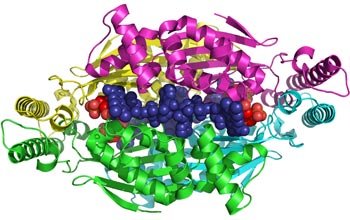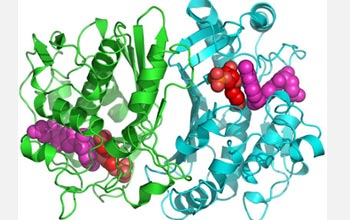All Images
News Release 09-072
Scientists Discover New Chemical Reaction for DNA Production in Bacteria and Viruses
Findings could help lead to development of new antibacterial and antiviral drugs
This material is available primarily for archival purposes. Telephone numbers or other contact information may be out of date; please see current contact information at media contacts.

Cartoon diagram of a Thermotoga maritima bacterium flavin-dependent thymidylate synthase, or FDTS, enzyme, which is an example of the class of FDTS enzymes. The FDTS enzyme is coded by the thyX gene and has been found primarily in bacteria and viruses, including several human pathogens and biological warfare agents. The two compounds involved in the active site of the enzymatic reaction, FAD and deoxy-uridine monophosphate, are represented by the small bluish-purple and red grouped spheres, respectively, and are enclosed by four protein sub-units depicted by green, light blue, gold and pink magenta ribbon-like structures.
Credit: Amnon Kohen, University of Iowa
Download the high-resolution JPG version of the image. (300 KB)
Use your mouse to right-click (Mac users may need to Ctrl-click) the link above and choose the option that will save the file or target to your computer.

Cartoon diagram of an Escherichia coli bacterium thymidylate synthase, or TS, enzyme, which is an example of classical TS enzymes. The TS enzyme is coded by the thyA and TYMS genes and is present in most multi-cellular forms of life, including humans. The compound deoxy-uridine monophosphate and an inhibitor molecule are represented by the small red and magenta grouped spheres, respectively, in the active sites of the enzyme. The green and light blue ribbon structures are the protein sub-units.
Credit: Amnon Kohen, University of Iowa
Download the high-resolution JPG version of the image. (94 KB)
Use your mouse to right-click (Mac users may need to Ctrl-click) the link above and choose the option that will save the file or target to your computer.


